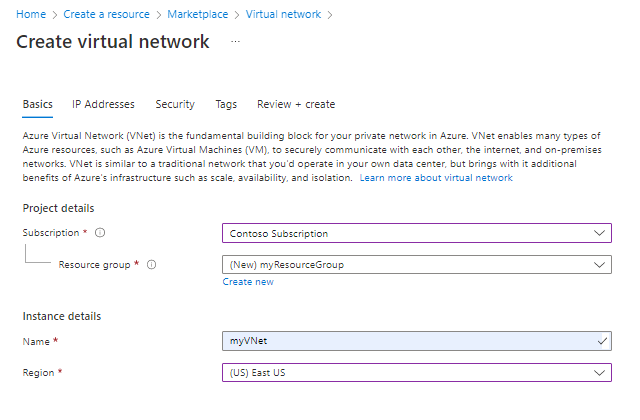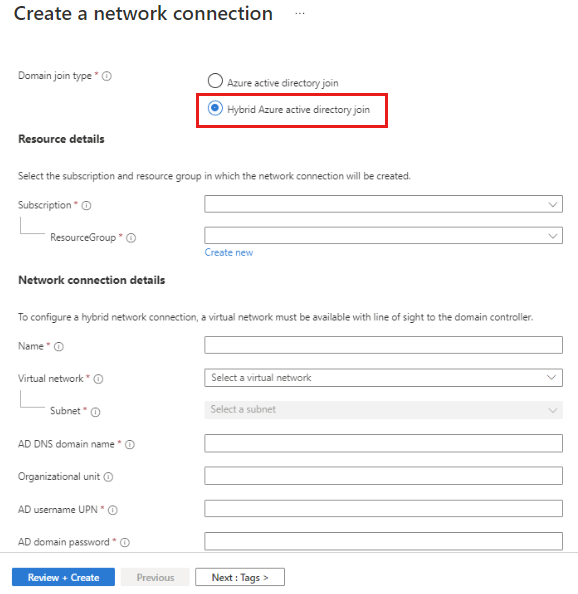Note
Access to this page requires authorization. You can try signing in or changing directories.
Access to this page requires authorization. You can try changing directories.
In this article, you learn how to manage network connections for a dev center in Microsoft Dev Box. Network connections enable dev boxes to connect to existing virtual networks. In addition, you can configure the network settings to enable connecting to on-premises resources from your dev box. The location, or Azure region, of the network connection determines where associated dev boxes are hosted.
You can choose to deploy dev boxes to a Microsoft-hosted network associated with a dev box pool or to a network that you manage. If you choose to deploy dev boxes to a network that you manage, you must first configure a network connection.
You need to add at least one network connection to a dev center in Microsoft Dev Box.
Prerequisites
- Sufficient permissions to enable creating and configuring network connections.
- At least one virtual network and subnet available for your dev boxes.
When you're planning network connectivity for your dev boxes, consider the following points:
- Identify the region or location that's closest to your dev box users. Deploying dev boxes into a region that's close to users gives them a better experience.
- Determine whether dev boxes should connect to your existing networks by using Microsoft Entra join or Microsoft Entra hybrid join.
Verify your permissions
To manage a network connection, confirm you have the following permissions:
| Action | Role | Permissions required |
|---|---|---|
| Create and configure a virtual network and subnet | Network Contributor (Owner or Contributor) | Permissions on an existing virtual network or permission to create a new virtual network and subnet |
| Create or delete a network connection | Owner or Contributor | Permissions on an Azure subscription or on a specific resource group, which includes permission to create a resource group |
| Add or remove a network connection | Contributor | Permission to perform Write actions on the dev center |
Create a virtual network and subnet
To create a network connection, you need an existing virtual network and subnet. If you don't have a virtual network and subnet available, use the following steps to create these resources:
Sign in to the Azure portal.
In the search box, enter virtual network. In the list of results, select Virtual networks.
On the Virtual networks page, select + Create.
On the Create virtual network pane, configure the following values on the Basics tab:
Setting Value Subscription Select your subscription. Resource group Select an existing resource group, or create a new resource by selecting Create new, entering a name, and then selecting OK. Virtual network name Enter a name for the virtual network. Region Select the region for the virtual network and dev boxes. Important
The region you select for the virtual network is where Azure deploys the dev boxes.
On the Security tab, accept the default settings.
On the IP addresses tab, accept the default settings.
On the Review + create tab, review the settings.
After validation passes for your configuration, select Create.
This procedure creates a virtual network and a default subnet.
Allow access to Microsoft Dev Box endpoints from your network
An organization can control network ingress and egress by using a firewall, network security groups, and even Microsoft Defender.
If your organization routes egress traffic through a firewall, you need to open certain ports to allow the Microsoft Dev Box service to function. For more information, see Network requirements.
Plan a network connection
The following sections show how to create and configure a network connection in Microsoft Dev Box.
Review types of Active Directory join
Microsoft Dev Box requires a configured and working Active Directory join, which defines how dev boxes join your domain and access resources. You have two choices:
Microsoft Entra join: If your organization uses Microsoft Entra ID, you can use a Microsoft Entra join (sometimes called a native Microsoft Entra join). Dev box users sign in to Microsoft Entra joined dev boxes by using their Microsoft Entra account. They access resources based on the permissions assigned to that account. Microsoft Entra join enables access to cloud-based and on-premises apps and resources. For more information, see Plan your Microsoft Entra join deployment.
Microsoft Entra hybrid join: If your organization has an on-premises Active Directory implementation, you can still benefit from some of the functionality in Microsoft Entra ID by using Microsoft Entra hybrid joined dev boxes. These dev boxes are joined to your on-premises Active Directory instance and registered with Microsoft Entra ID. Microsoft Entra hybrid joined dev boxes require network line of sight to your on-premises domain controllers periodically. Without this connection, devices become unusable. For more information, see Plan your Microsoft Entra hybrid join deployment.
Create a network connection
Use the following procedures to create a network connection for your dev box configuration.
Sign in to the Azure portal.
In the search box, enter network connections. In the list of results, select Network connections.
On the Network connections page, select + Create:
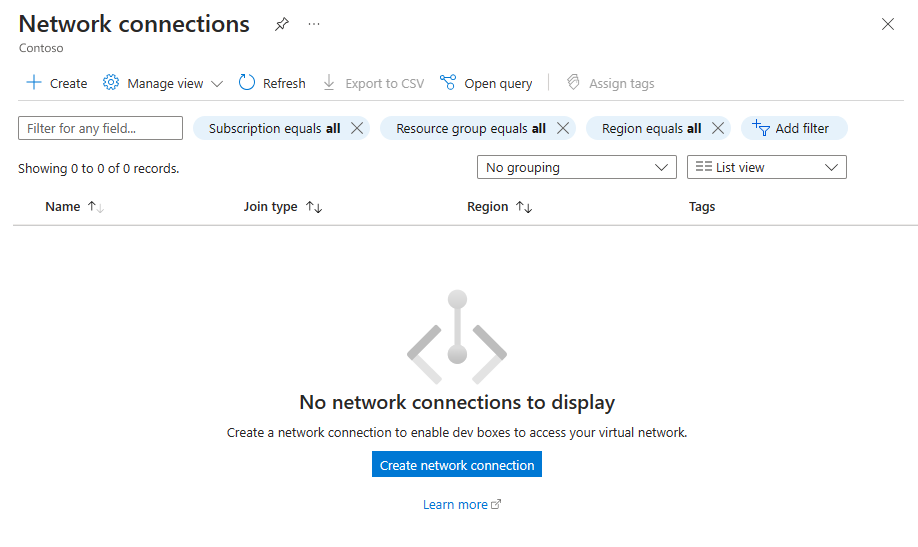
On the Create a network connection pane, configure the following values on the Basics tab:
Setting Value Domain join type Select Azure active directory join (for Microsoft Entra join). Subscription Select the subscription in which you want to create the network connection. Resource group Select an existing resource group, or select Create new and then enter a name for the new resource group. Name Enter a descriptive name for the network connection. Virtual network Select the virtual network that you want the network connection to use. Subnet Select the subnet that you want the network connection to use. 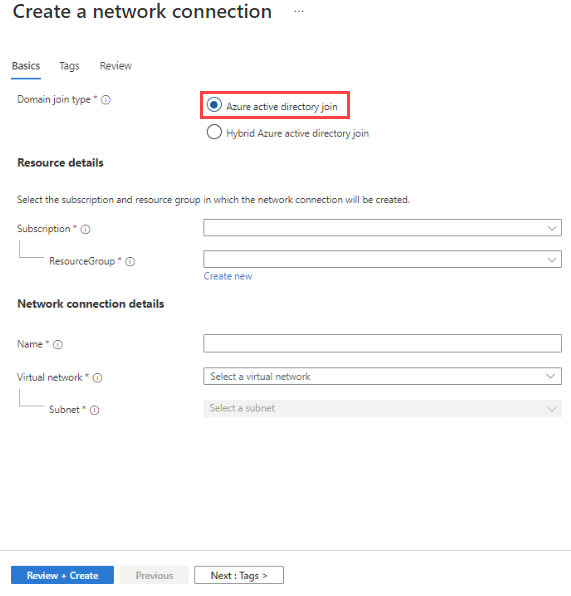
On the Review + create tab, review the settings.
After validation passes for your configuration, select Create.
After the deployment completes, select Go to resource. Confirm the connection appears on the Network connections page.
Note
Microsoft Dev Box automatically creates a resource group for each network connection, which holds the network interface cards (NICs) that use the virtual network assigned to the network connection. The resource group has a fixed name based on the name and region of the network connection. You can't change the name of the resource group, or specify an existing resource group.
Attach and remove network connections
Network connections enable dev boxes to connect to existing virtual networks. The location or Azure region of the network connection determines where associated dev boxes are hosted.
If you have an existing network connection you want to use with Microsoft Dev Box, you must attach it to a dev center before you can use it for dev box projects and pools. You can attach multiple network connections to a dev center.
Attach a network connection to a dev center
To attach a network connection to a dev center:
In the Azure portal, go to the page for the dev center you want to attach the network connection to.
On the dev center page, select Networking under Dev box configuration in the left navigation menu.
On the Networking page, select Add.
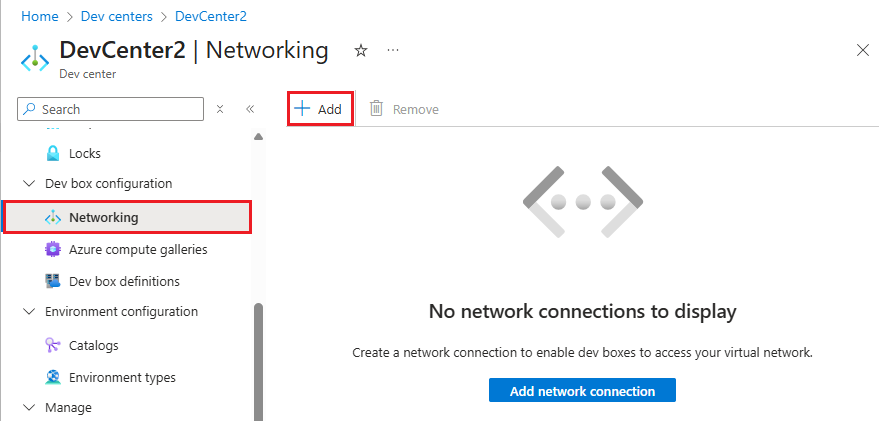
On the Add network connection pane, select the network connection you want to use, and then select Add:
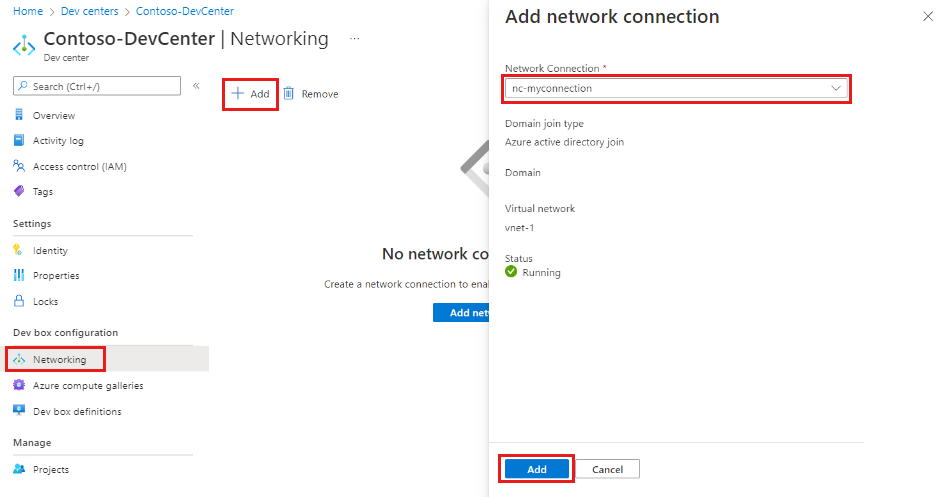
After you attach the network connection, the Azure portal runs several health checks on the network. You can view the status of the checks on the dev center Networking page.

If all the health checks pass, the network connection is added to the dev center and you can select it when you create dev box pools. Dev boxes in the pools are created and domain-joined in the virtual network location assigned to the network connection.
To address health check errors and issues, see Troubleshoot Azure network connections.
Remove a network connection from a dev center
Follow these steps to remove an attached network connection from a dev center.
Note
If the network connection is in use by one or more dev centers, you can't remove it.
In the Azure portal, select the dev center that has the connection you want to remove.
On the dev center page, select Networking under Dev box configuration in the left navigation menu.
Select the network connection you want to remove and then select Remove.

Respond OK to the confirmation message.
After you remove a network connection, it's no longer available for use by dev box pools in the dev center.
